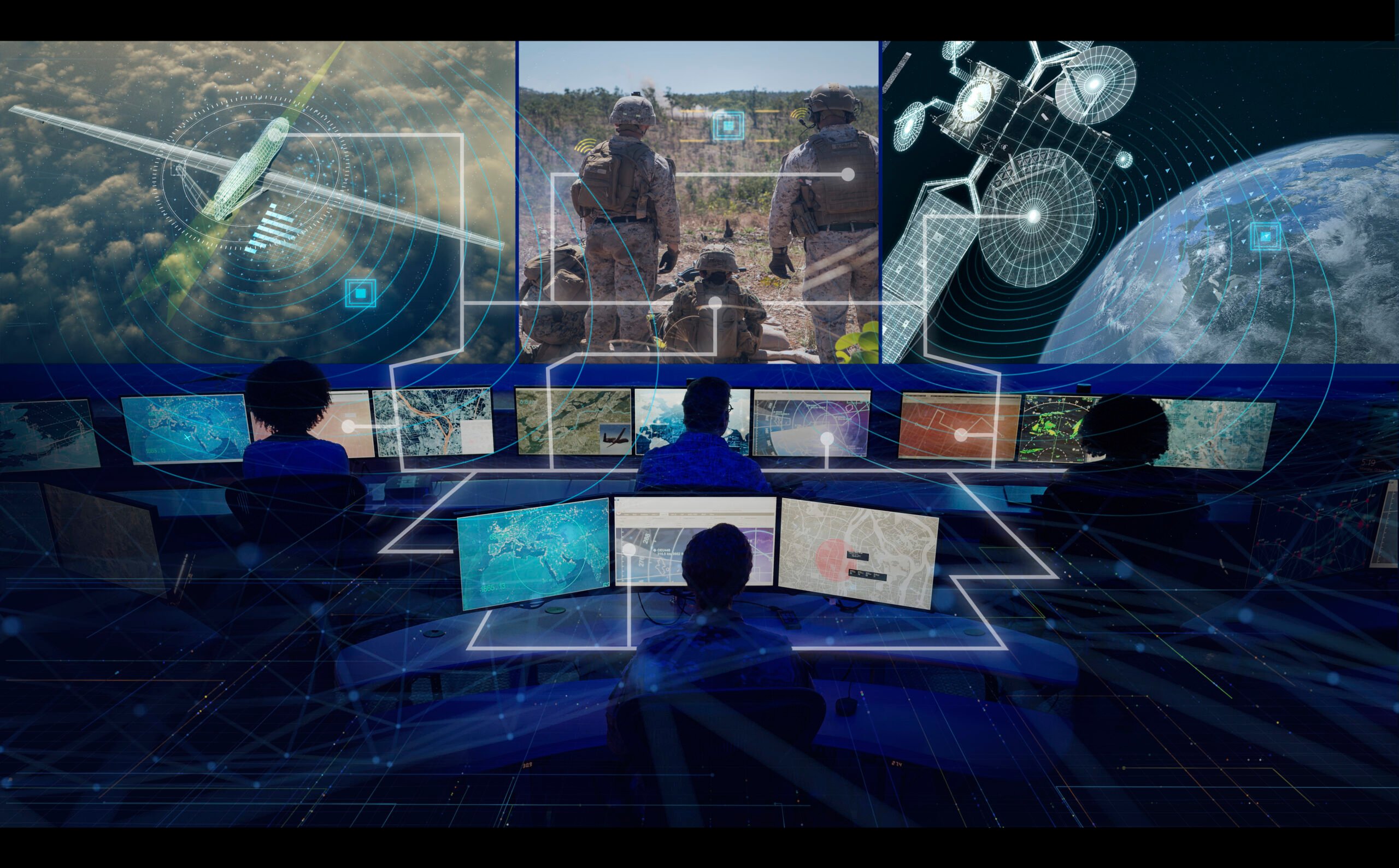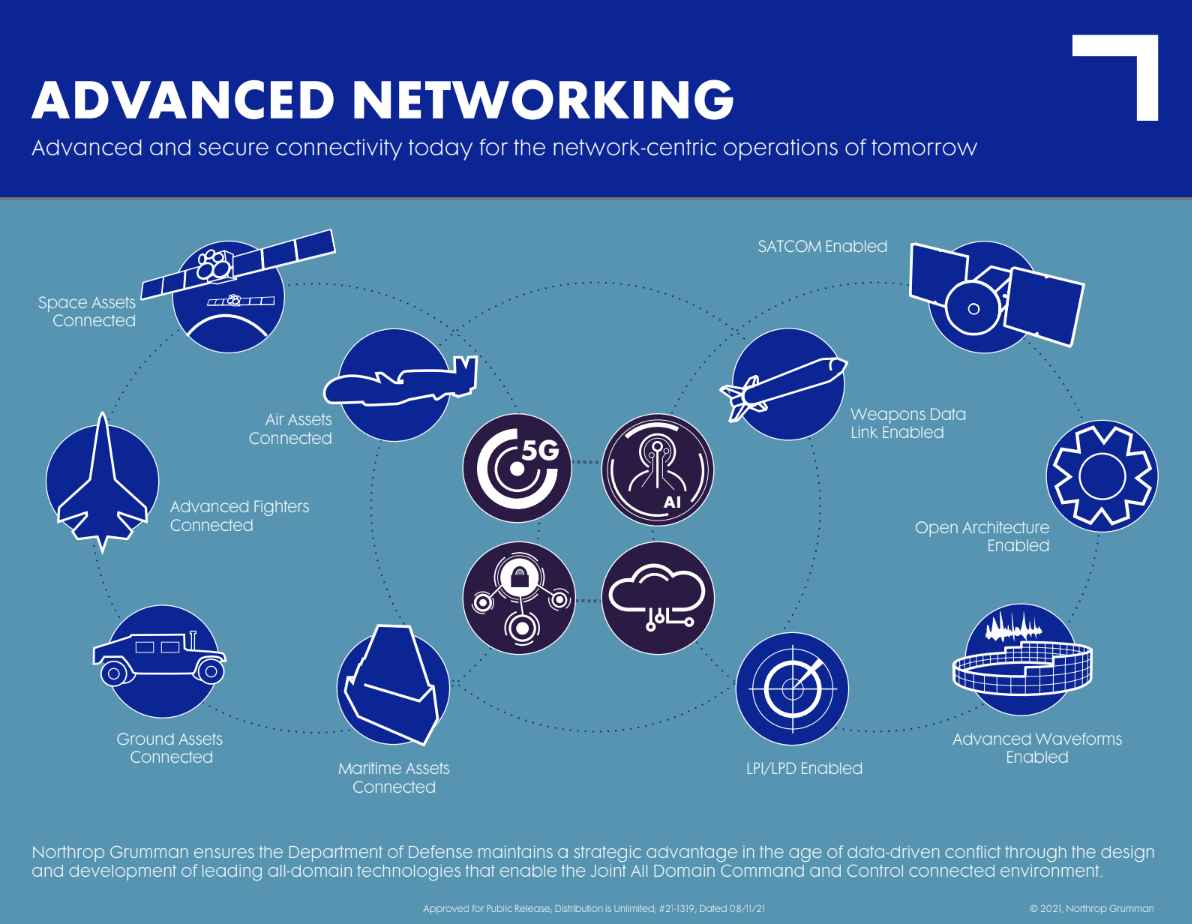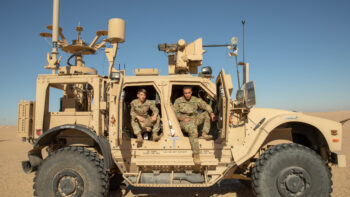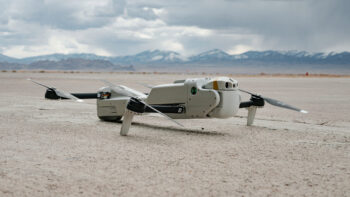
Northrop Grumman presents its vision for what it calls the “digital battle network” and architecture in this graphic. Photo courtesy of Northrop Grumman.
In this Q&A with Jenna Paukstis, vice president, communications solutions business unit, Northrop Grumman, she discusses: how the enabling technologies of JADC2 can be brought together in a “digital battle network”; the company’s 5G partnership with AT&T; and the company’s portfolio of open-architecture, platform-agnostic solutions that are designed to help the Department of Defense connect communications nodes, shooters, and platforms across all domains and branches.
Breaking Defense: Northrop Grumman has many of the enabling technologies to connect the joint force, including gateways, 5G commercial partnerships, edge processing, AI/ML, space, and command and control systems. What’s the thread and connective tissue between those enabling technologies, and how specifically does the combination create the JADC2 capabilities DoD needs?

Jenna Paukstis, vice president, communications solutions business unit, Northrop Grumman.
Paukstis: The key to the future of defense is connecting those enabling technologies into what we call the “digital battle network” and architecture that leverages the latest commercial and defense technology along with Northrop Grumman’s mission expertise across all domains to enable real-time decision making. That’s the game changer that the United States Air Force and other services are looking for.
When you think about JADC2 connecting communications nodes and platforms across all domains and branches, advanced networking capabilities become a critical enabler. You need both an enterprise-level and a theater-level network of networks that can provide a dynamic mission architecture in real time across disparate domains.
That’s important in developing a multi-mission focus because in any given theater you’ll need to converge networks to seamlessly appear as a single network to the user to ensure the right data gets to the right user at the right time.
With those focus areas in mind, we’re pushing technology to the edge so we can define what’s possible in terms of the mission. Our customers look to us to deliver the next generation of innovative capabilities that will continue to provide strategic advantages to enable deterrence in this new age of information-driven warfare and rapidly advancing threats.
In response, we’re accelerating our focus on the key technology areas that you named with a focus on integrating connectivity, processing, and intelligence so we can enable our customers to achieve information overmatch, particularly in contested environments.
For that, our customers need what I call the “mission-aware network” that can morph as needed. We can provide almost any-to-any connectivity depending on the demands of the mission, and how those demands change in theater.

Northrop Grumman’s advanced networking will result in a “mission-aware network” that can morph as needed, as illustrated in this graphic. Graphic courtesy of Northrop Grumman.
Breaking Defense: Tell me about your partnership with AT&T to research and develop a 5G digital battle network to support the DoD. How does this network create the high speeds, low latency, cybersecurity protections, and scalability needed for JADC2?
Paukstis: Northrop Grumman is investing broadly in commercial 5G partnerships such as the one with AT&T to create a digital battle network. That’s important because it creates the dynamic, scalable, and resilient architectures that leverage the power of 5G and commercial technology with the security, mission awareness, and range that we need in a JADC2 environment.
The key is enabling the architectural building blocks that we can get from commercial industry to fit into our warfighting ecosystem. That lets us take advantage of both the scale and the technology that comes from commercial industry while still giving our customers the ability to own, compete, and protect the architecture through security protocols.
This makes it possible to redefine the mission so customers can reconstruct the network on the fly to support various missions as they move to intelligent mission-aware networks. This is one of the key steps toward achieving a next-generation battle network. These networks require AI and resource management that uses both tactical and commercial network solutions. They also enable the use of legacy platforms in new ways, such as a gateway or communications relay.
The digital battle network provides the network, resilience, and security management and controls with additional compute power for real-time processing at the edge. This will bring support for low-latency operations and data reduction. Open architecture enables the rapid deployment of those new capabilities on a global scale to ensure we can get the right data to the right shooter at the right time in order to shorten sensor-to-shooter engagement timelines in the multi-domain environment.
We’re leveraging partnerships with AT&T and commercial industry as a whole, in several different use-case areas — JADC2 to include things like: networked platforms, sensors, and weapons; space-to-air and space-to-ground; as well as a set of use cases that are enabling efficiencies, digital transformation, and zero trust architectures for the “Factory and Flightline of the Future.” The possibilities are endless and very exciting.
Breaking Defense: Moving on to open architecture and platform agnostic solutions, tell me about the latest developments in your Software Programmable Open Mission System Compliant (SPOC) solution, including the recent demonstration with Kratos that validated third-party integrations. What’s the connection to JADC2?
Paukstis: SPOC is part of our portfolio of open architecture, platform-agnostic solutions that are designed to connect communications nodes, shooters, and platforms across all domains and branches, as well as supporting the future of network or data-centric operations.
The demonstration of our SPOC radio terminal successfully showed that we could connect third-party industry providers and securely share information over the air in a platform-agnostic all-domain environment.
We were able to do that with our Open Software Development Kit which drastically reduces development and integration lead time, a critical component going forward to rapidly deploy new capabilities.
In terms of our SPOC offering, the open architecture provides numerous benefits to our customers, including: integrated communications, navigation, and identification capabilities; allowing third-party developers to incorporate their capabilities; ownership of Link 16; and sharing intelligence, surveillance, and reconnaissance information over a common data link.
Our family of radios improves situational awareness and enhances overall mission effectiveness by enabling multi-level, secure 5th-to-5th and 5th-to-4th generation, and next-generation networked data sharing that provides interoperability across joint and coalition forces.
Breaking Defense: Your Integrated Communications, Navigation, and Identification (iCNI) system provides more than 27 functions. Tell me about that and the recent demonstration of a smaller version (Mini-CNI) of the platform to help with the Army’s aviation ecosystem modernization efforts. Connect that back to capabilities for JADC2?
Paukstis: Our iCNI system is part of our family of platform-agnostic, open architecture offerings. We’ve been providing integrated communications, navigation, and identification for decades, right up to the F-35.
Recently, we built the Mini-CNI system by leveraging radio offerings that we talked about from the SPOC product line with our multi-level security technology to deliver a number of capabilities that can operate simultaneously and securely. The development of this system helps greatly reduce the size, weight, and power demand, which is important, especially when you’re talking about Army platforms.
The recent demonstration proved our ability to provide an open architecture, in-flight connectivity, interoperability, and network management capability for vertical-lift platforms. During a series of demos, we were able to progressively add additional capability in a matter of weeks and months, not years, which again, speaks to the value of open architecture in being able to rapidly deploy new capabilities in drastically reduced lead time.
This proven technology enhances overall mission effectiveness for a variety of platforms for the Army and other services and extends the operational reach of joint and coalition partners – improving lethality, survivability, and targeting against any threat by enabling decision dominance at speed across multi-domain operating environments.
Breaking Defense: You’re also investing in development of low SWaP gateway systems that are designed to enable communications and cross-domain translations between multiple beyond line-of-sight and line-of-sight networks and datalinks. Tell me about that.
Paukstis: Similar to our earlier discussion around intelligent mission-aware networks that lead to next-generation digital battle networks, our next-generation of platform-agnostic gateways provide intelligent and mission-aware, cyber-secure routing and data translation through integrated functions like cloud computing, machine learning, and artificial intelligence.
Effectively translating data between previously siloed legacy platforms and next-generation systems, while also providing all-domain, interconnected, near-real time communication links in a resilient and secure manner, are outcomes that our warfighters and government customers need to continue their strategic advantage. It shouldn’t matter where the data comes from as long as we can securely access it exactly where and when it’s needed.
Breaking Defense: Northrop Grumman was recently selected to build a secure connective networking layer in space with Aeronix. Northrop Grumman will develop a Space End Crypto Unit (ECU) prototype that will connect platforms and weapons in low-Earth orbit across common architecture, providing added network security to critical missions for the Space Force. Bring us up to date on that.
Paukstis: That’s another good example of how we’re able to leverage this technology across multiple domains. The Space End Crypto Unit is also part of our portfolio of platform-agnostic solutions. By leveraging what we call our Crypto Development Kit, we proved that third-party developers can further contribute to the rich library of cryptographic algorithms.
Northrop Grumman’s investment into a crypto-based product line utilizes a flexible, high throughput design based on a single-chip reprogrammable solution. The Space End Crypto Unit will provide a connected network solution that helps warfighters make decisions faster across a full range of platforms.
The prototype will be built to survive in the space environment and deployed on satellites. It can also be deployed in multiple other environments, including ground stations and on aircraft.
Breaking Defense: Late last year, Breaking Defense wrote that Northrop Grumman will flight test its software-defined satellite communications radio. What’s new with that?
Paukstis: We recently completed a lab demonstration that integrated a low-Earth orbit, commercial satellite Internet communications capability into the existing product line, utilizing the software-defined nature of our radio product line.
The demo further displayed our ability to evolve to meet future mission demands and to provide functionality needed to enable multi-level secure network data sharing in order to connect the fleet aviation ecosystem with ground, joint and coalition forces. We have a flight demonstration scheduled for later this year.





















